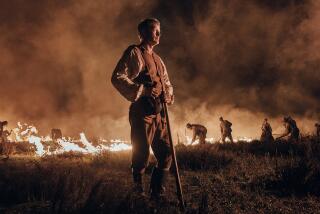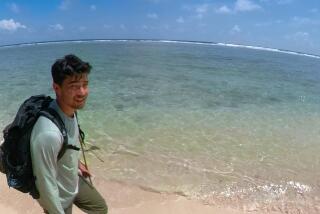Kingdom at the Edge of the World
- Share via
Open an atlas to the page where the world lies flat and four-cornered, and you’ll find an island in the Southern Ocean, less than 1,500 miles from Antarctica, equidistant from Australia and South Africa. Look closely and you’ll see that it’s less an island than an archipelago: the Kerguelen Islands.
A messy ink splat for cartographers, this dense cluster of islands, inlets, lakes and mountains is not easily drawn, much less considered. Except by Jean-Paul Kauffman, who as a child reading “Treasure Island” and the adventure comic Spirou dreamed of one day stepping foot upon this fantastic land, also known as the Iles de Desolation, familiar to readers of Patrick O’Brian as the Desolation Islands.
That day came to pass in 1991, when Kauffman boarded a freighter at Reunion Island off Madagascar for the weeklong voyage south. The tale that he returns to tell is “The Arch of Kerguelen,” his dream made real: part travelogue, part history, part naturalist diary, a mesmerizing portrait of the most inspiring place in the world you’ll never visit.
The Desolation Islands leap straight out of the imagination of Dante, of Edgar Allan Poe and German Romantic painter Caspar David Friedrich. Kauffman had initially wanted to take this trip to see the island’s famous arch, one of the natural wonders of the forgotten world, standing more than 300 feet high. Though the arch has fallen, its remnants are said to stand like the twin towers of Notre Dame.
But getting to the arch, situated on the most remote corner of the island, is no easy matter, and from the moment he steps ashore, a land of rushing waters, basalt crags and vast peat bogs confronts him, as if it had “just come into being,” as if God had “stopped at the fifth day with the birds and the fishes.”
Trekking its interior in the company of researchers and parachutists practicing survival skills, Kauffman travels through the science and literature of the region, drawing portraits of the dreamers like himself who have been inextricably drawn to this desolation.
Perhaps the most hopeless dreamer was Yves-Joseph de Kerguelen, a captain in the navy of Louis XV, who, upon sighting this windy desolate land in 1772, was filled with such disappointment that he disdained setting foot upon it. His king, however, was less displeased, and ordered a second reconnaissance (though detractors in the court claimed that the chevalier never saw land but only a cloud on the horizon). Kerguelen begrudgingly obeyed but resorted to sweetening the voyage as best he could. A year later, upon his return, he was thrown in jail for having taken a woman aboard the ship.
Solitude is, of course, the test of all obsession, and Kauffman travels within his own soul during his tenure upon the island. “Desolation Island is situated . . . somewhere between elsewhere and everywhere,” he tells us. “Could Kerguelen be nothing more than the reality of my life in its pure state? It defies every idea of the picturesque, the exotic and the voyage. Could I have invented a whole picture of the Desolation Isles before I left France? I carry that kind of devastation within me.”
Author of the much-praised “The Black Room at Longwood,” the story of Napoleon’s exile on St. Helena, Kauffman is clearly drawn to forbidding places, an affinity that takes on greater significance when you realize that he spent three years as a hostage in Beirut in the 1980s. He writes today as if in compensation for that time in darkness.
“Light suddenly streams out between the clouds, and through the fine droplets of water, throwing a huge rainbow from the mountain to the valley,” he observes during one venture into the interior. “The colors of the celestial arch are so clear that, when I hold out my hand towards the rainbow, a shower of gold and turquoise falls into my palm. The drops are pointed like diamonds and so cold that they scratch my skin and prick my hot face.”
His meditation is by degrees eccentric. His language has the freshness of aphorism and the resonance of truth. He is Bruce Chatwin’s heir: Let him declare that describing “the color of the sky has always seemed . . . one of the noblest and wisest of man’s occupations,” and you will understand why.
“The ecosystem!” he writes. “What an ugly word! . . . Since nature produced ecosystems (1969), I no longer read La Fontaine’s ‘Fables’ with the same pleasure. The concept of the biotope has really taken the poetry out of nature, populated until then by grasshoppers, rabbits, and frogs.” Yet happily he restores the poetry and creates stories within the story not unlike the best short fiction. Can this really be true, you find yourself asking. Or is this the land that Jorge Luis Borges dreamed of or Italo Calvino imagined?
“Inexhaustible nature gives generously of herself to whomever asks her,” Kauffman takes us by the hand. “In Kerguelen, the strong draw energy, the weak become exhausted, the dreamers become entrenched in their illusions. Everything people bring with them increases too quickly: rabbits, dreams. . . .”
As Kauffman fights the wind, storms and delayed transports to the arch, Kerguelen grows alternately less--and more--misty. At a time when we think of the planet as globalized--when we think that nothing is unknowable and everything is connected--Kerguelen proves our assumptions wrong.
Finish the last page of Kauffman’s book, let the Desolation Isles slip beyond the horizon to become once again a speck in the Southern Ocean. In your dreams and landlocked imaginings, these islands will loom as a place to visit, now more than ever.
More to Read
Sign up for The Wild
We’ll help you find the best places to hike, bike and run, as well as the perfect silent spots for meditation and yoga.
You may occasionally receive promotional content from the Los Angeles Times.







